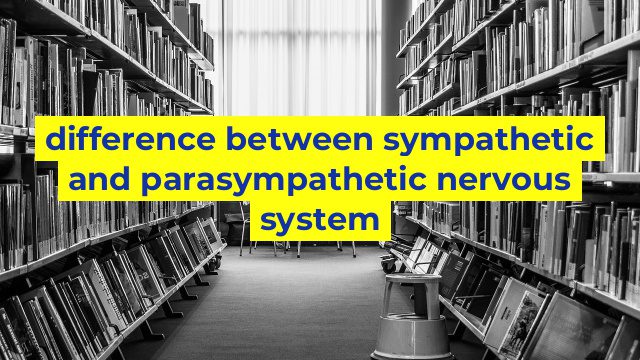Difference between Sympathetic and Parasympathetic Nervous System
The human body consists of many interconnected systems that work together to maintain the overall balance of the body. The nervous system, in particular, plays a crucial role in regulating and coordinating bodily functions. It comprises two major divisions, the sympathetic and parasympathetic nervous systems, which have several distinct differences.
Function and Location
The sympathetic nervous system (SNS) is responsible for preparing the body for the “fight or flight” response during times of stress or danger. It originates in the spinal cord’s thoracic and lumbar regions and has adrenergic (norepinephrine) neurons that connect to target organs. Some of its functions include:
– Increasing heart rate and blood pressure
– Dilating pupils
– Expanding airways in the lungs
– Constricting blood vessels in the skin and digestive system
On the other hand, the parasympathetic nervous system (PNS) controls the body’s “rest and digest” response during calm or non-stressful situations. It arises in the cranial and sacral regions of the spinal cord and has cholinergic (acetylcholine) neurons that innervate target organs. It’s responsible for:
– Decreasing heart rate and blood pressure
– Constricting pupils
– Constricting airways in the lungs
– Dilating blood vessels in the digestive system
Neurotransmitters and Receptors
As mentioned, the SNS releases norepinephrine to stimulate target tissues, while the PNS releases acetylcholine to inhibit them. Both systems also have different receptor subtypes that respond to these neurotransmitters. The SNS primarily activates alpha and beta receptors, while the PNS stimulates nicotinic and muscarinic receptors. Activation of alpha and beta receptors, for example, can cause a range of responses, such as elevated blood sugar levels and increased sweating.
Timing and Effects
Both the SNS and PNS have instantaneous effects on the body, but they differ in their duration and intensity. The SNS generally produces more prolonged and widespread effects than the PNS. It also activates more quickly and more intensely during a stressful event. However, PNS activity tends to dominate during non-stressful or restful periods, slowing down the body’s metabolism and promoting relaxation.
Conclusion
In summary, the sympathetic and parasympathetic nervous systems play significant roles in regulating various bodily functions. While they are both essential, they have different functions, locations, neurotransmitters, and effects on the body. Understanding their differences can help individuals appreciate how their body works and how to manage stress better for optimal health.
Table difference between sympathetic and parasympathetic nervous system
| Aspect | Sympathetic Nervous System | Parasympathetic Nervous System |
|---|---|---|
| Location of Origin | Thoracic and lumbar spinal cord | Cranial and sacral spinal cord |
| Effect on Heart Rate | Increases heart rate and blood pressure | Decreases heart rate and blood pressure |
| Effect on Digestive System | Inhibits digestive activity | Stimulates digestive activity |
| Effect on Pupils | Dilates pupils | Constricts pupils |
| Effect on Bronchi | Dilates bronchi | Constricts bronchi |
| Effect on Bladder | Relaxes bladder muscles | Contracts bladder muscles |


